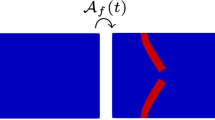In this paper the so-called added-mass effect is investigated from a different point of view of previous publications. The monolithic fluid structure problem is partitioned using a static condensation of the velocity terms. Following this procedure the classical stabilized projection method for incompressible fluid flows is introduced. The procedure allows obtaining a new pressure segregated scheme for fluid-structure interaction problems which has good convergent characteristics even for biomechanical application, where the added mass effect is strong. The procedure reveals its power when it is shown that the same projection technique must be implemented in staggered FSI methods.
Access this chapter
Tax calculation will be finalised at checkout
Purchases are for personal use only
Preview
Unable to display preview. Download preview PDF.
Similar content being viewed by others
References
Felippa CA, Park KC (1980) Staggered transient analysis procedures for coupled-field mechanical systems: formulation. Comput Meth Appl Mech Eng 24:61–111
Farhat C, Leisoinne M, LeTallec P (1998) Load and motion transfer algorithms for fluid/structure interaction problems with non-matching discrete interfaces: momentum and energy conservation, optimal discretization and application to aeroelasticity. Comput Meth Appl Mech Eng 157:95–114
Piperno S, Farhat C (2001) Partitioned procedures for the transient solution of coupled aeroelastic problems- Part II. Comput Meth Appl Mech Eng 190:3147–3170
Neumann M, Tiyyagura SR, Wall WA, Ramm E (2006) Robustness and efficiency aspects for computational fluid structure interaction. Computational Science and High Performance Computing II, Springer, Berlin/Heidelberg, ISSN 1612-2909, vol. 91
Lohner R, Yang C, Cebral J, Baum JD, Luo H, Pelessone D (1995) Fluid-structure interaction using a loose coupling algorithm and adaptive unstructured grids. In: Oshima K, Hafez M (eds) Computational Fluid Dynamics Review, Wiley, Chichester
Rugonyi S, Bathe KJ (2000) On the analysis of fully-coupled fluid flows with structural interactions-a coupling and condensation procedure. Int J Comput Civil Struct Eng 1:29–41
Rugonyi S, Bathe KJ (2001) On finite element analysis of fluid flows fully coupled with structural interactions. Comput Model Simulat Eng (CMES) 2:195–212
Souli M, Ouahsine A, Lewin L (2000) Arbitrary Lagrangian-Eulerian formulation for fluid-structure interaction problems. Comput Meth Appl Mech Eng 190:659–675
Le Tallec P, Mouro J (2001) Fluid structure interaction with large structural displacements. Comput Meth Appl Mech Eng 190:3039–3067
Felippa CA, Park KC, Farhat C (2001) Partitioned analysis of coupled mechanical systems. Comput Meth Appl Mech Eng 190:3247–3270
Walhorn E, Kolke A, Hubnerm B, Dinkler D (2005) Fluid-structure coupling within a monolithic model involving free surface flows. Comput Struct 83:2100–2111
Dettmer W, Peric D (2006) A computational framework for fluid-structure interaction: finite element formulation and applications. Comput Meth Appl Mech Eng 195:5754–5779
Causin P, Gerbeau JF, Vobile F (2001) Added-mass effect in the design of partitioned algorithms for fluid-structure problems. Comput Meth Appl Mech Eng 194(42–44):4506–4527
Badia S, Quanini A, Quarteroni A (2008) Splitting methods based on algebraic factorization for fluid-structure interactions. Personal communication
Chorin AJ (1968) Numerical solution of the Navier-Stokes equations. Math Comput 22:745– 762
Temam R (1969) Sur l'approximation de la solution des.equations de Navier-Stokes par la methode des pas fractionaires (I). Arch Ration Mech Anal 32:35–153
Onate E (2000) A stabilized finite element method for incompressible viscous flows using a finite increment calculus formulation. Comput Meth Appl Mech Eng 182(1–2):355–370
Author information
Authors and Affiliations
Editor information
Editors and Affiliations
Rights and permissions
Copyright information
© 2009 Springer Science + Business Media B.V
About this chapter
Cite this chapter
Idelsohn, S.R., Oñate, E., Rossi, R., Marti, J., Del Pin, F. (2009). New Computational Challenges in Fluid– Structure Interactions Problems. In: Eberhardsteiner, J., Hellmich, C., Mang, H.A., Périaux, J. (eds) ECCOMAS Multidisciplinary Jubilee Symposium. Computational Methods in Applied Sciences, vol 14. Springer, Dordrecht. https://doi.org/10.1007/978-1-4020-9231-2_2
Download citation
DOI: https://doi.org/10.1007/978-1-4020-9231-2_2
Publisher Name: Springer, Dordrecht
Print ISBN: 978-1-4020-9230-5
Online ISBN: 978-1-4020-9231-2
eBook Packages: EngineeringEngineering (R0)



